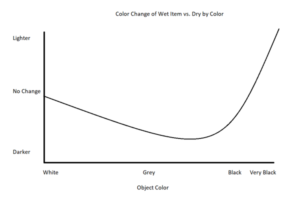Technical and Theoretical Considerations of Dark Colors
Prototypical color communication requires a light source, an object, and an observer. The light source illuminates the object and the object may reflect, scatter, or absorb the light. The observer then receives information about the resulting color of the object. This can be summarized by the visual depiction below.
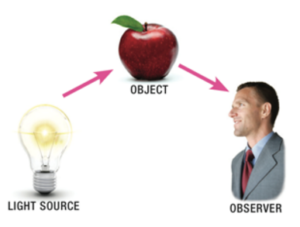
The physics definition of black is: receiving no (or little) visual spectrum radiation from the object. When we see a black colored object, physics dictates that we observe nothing.
Let’s consider what would be absolute black – the object absorbed all incident light. Your eyes (or a spectrophotometer) will receive no information from this object. It would appear as if someone had cut out the object in photo editing software. A recently developed material “Vantablack®” from Surrey NanoSystems – called the blackest of blacks – is this type of material. It is so black, that objects coated with it appear without shape; 3-dimensional objects seem 1-dimensional (Vantablack®).
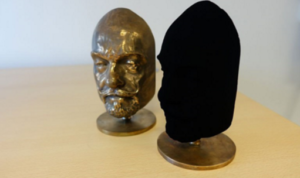
Let’s discuss the physics of what is happening for this near-absolute black. Vantablack® absorbs 99.965% of incident radiation at 750 nm and is mostly comprised of carbon nanotubes. Carbon effectively absorbs light, and the structure of the nanotubes help it become more efficient. On a small scale, the rod-like carbon nanotubes create deep voids and absorb incident light. If there is any specular reflection, the shape of the carbon nanotube helps direct the light deeper into the void between the carbon nanotubes. The structure of the carbon nanotubes help the Vantablack® obtain such a high absorbance of light.
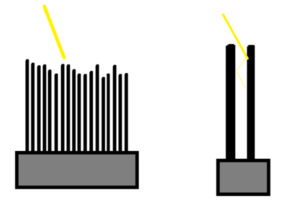
I will take a leap of faith and say that if we wetted the Vantablack® product, that it would have increased specular reflection (above its 99.965%). Wetted Vantablack® product would have more reflection than dry, and would be less black.
Dark colorants with higher degrees of scattering and reflection can be made darker (and black) through a different process. Consider that wet dirt is darker than dry dirt; or that a wet grey shirt is darker than when it is dry. What is happening in this situation?
“Why Some Things Are Darker Wet” predicts that a coating of water (polymer, oil, or other) on a surface will make it darker, due to light reflecting off the coating multiple times (Lekner and Dorf, 1988). With each reflection on the dark substrate, it absorbs light. Since more light is absorbed when wet than dry, the object appears darker.
We should note that if something is white, it does not get darker when wet. Conceptually, the paper posits in the diagram below follows the path of a beam of light through a wetted object, having many opportunities to be absorbed by the substrate.
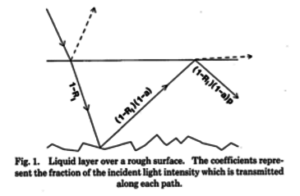
The paper of why things are darker when wet is math intensive, but gives you a great introduction to this theory. The paper is available at the link here: http://www.victoria.ac.nz/scps/about/staff/pdf/darkerwhenwet.pdf
Let’s wrap this up by summarizing that:
1. Things that are white will not become darker when wet.
2. For most colors, wetter things are darker than dry things.
3. If things are really really dark, any additional reflection will likely make it look lighter.
If we graph this out for white-grey-black colors, we would have this competing model of how much darker things become when they are wet compared to dry. If you have any additional questions, feel free to contact me by clicking the picture below.



